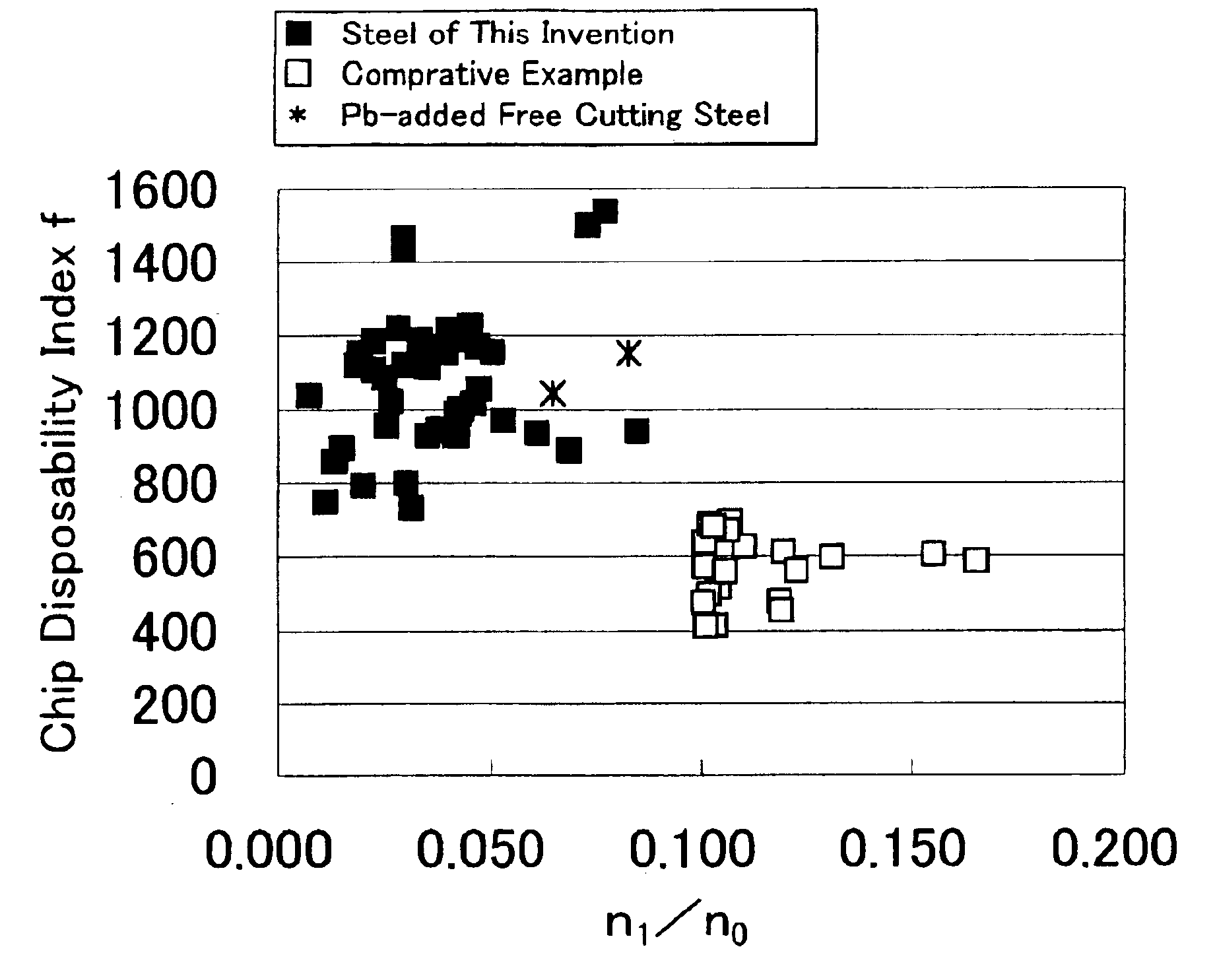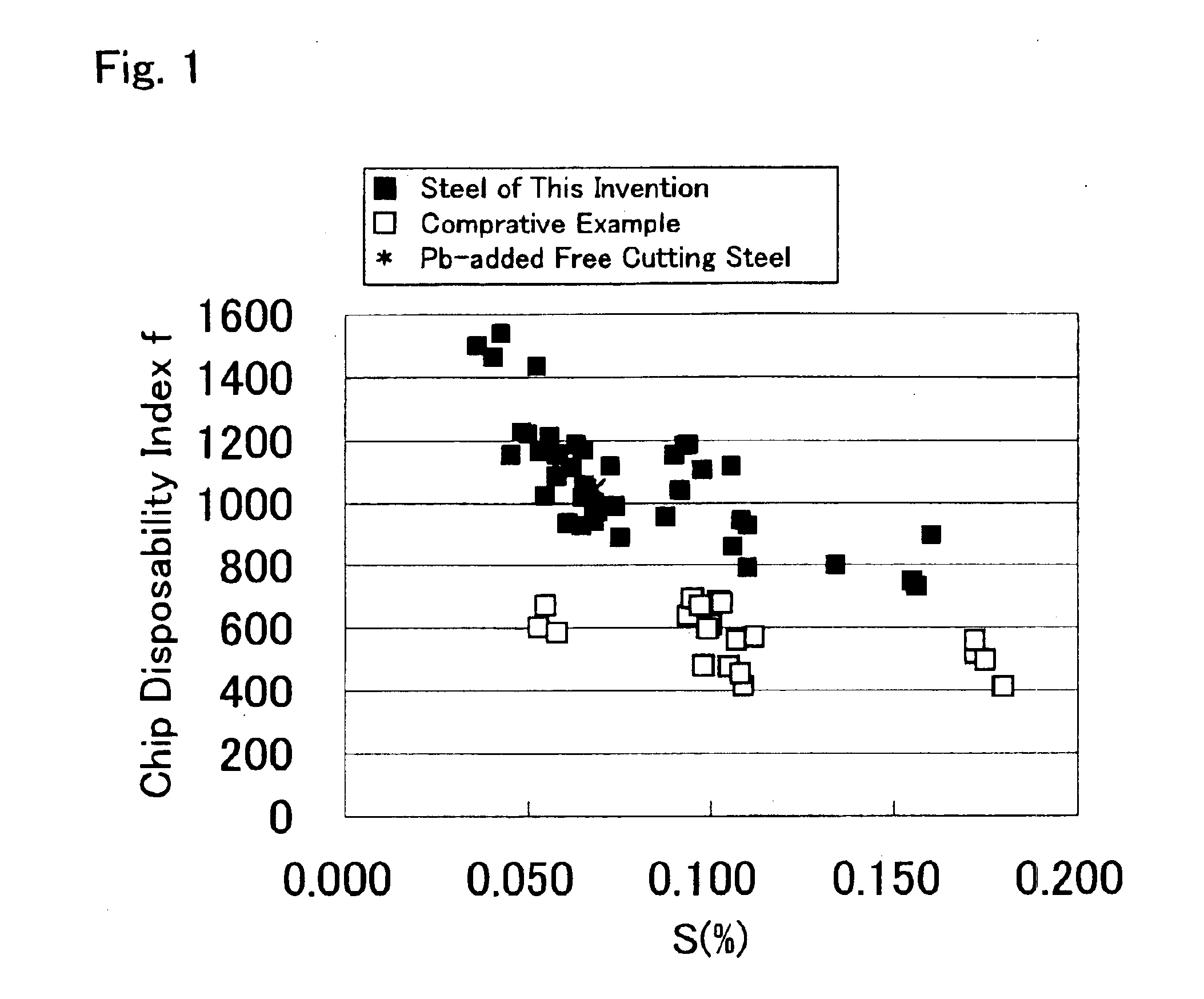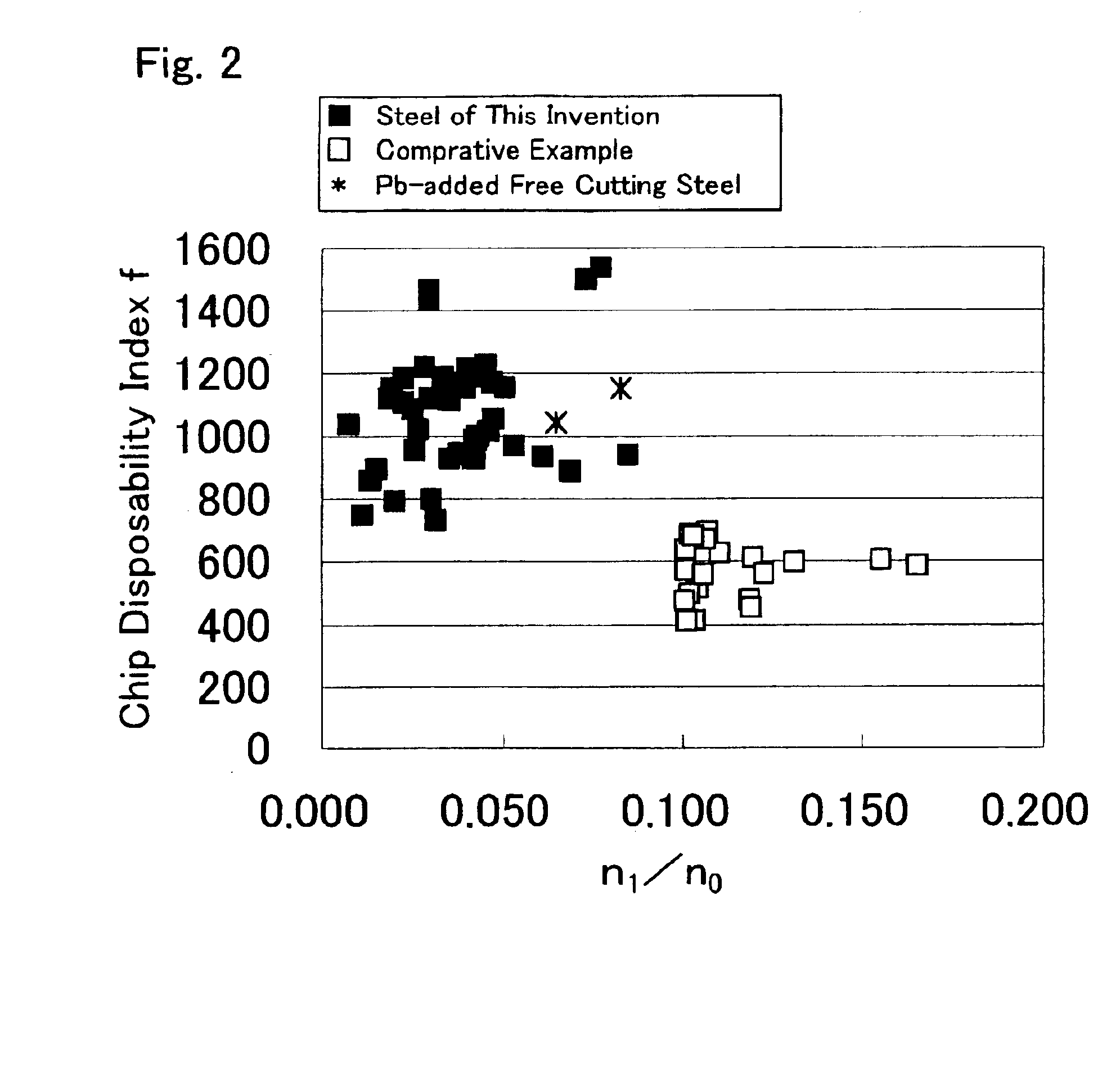However, addition of Pb not only increases the cost of steel but also may lead to environmental
contamination.
Therefore, the improvement in
chip disposability is not entirely satisfactory.
In addition, because the steel is Al-killed steel, even
after treatment with Ca, the
oxide inclusions are of the CaO--Al.sub.2 O.sub.3 type, hence the improving effects on the
machinability such as tool life are not very satisfactory.
When an attempt is made to disperse a large number of
sulfide inclusions containing a
high concentration of CaS by increasing the S concentration, addition of a large amount of Ca is required, and this disadvantageously causes an increase in cost.
In such a case, the oxides in steel are mainly hard Al.sub.2 O.sub.3 type oxides, and the tool life is improved only to an unsatisfactory extent.
However, increase of such
sulfide of high Ca content makes the sulfide coarse and makes improvement of
chip disposability difficult.
In this case, however, individual sulfide inclusions become coarse, whereby that sulfide morphology suited for providing good chip disposability cannot he obtained, hence the improvement in chip disposability is not yet satisfactory.
However, it cannot be said that sufficient considerations have been given to the level of addition of Ca, the timing of addition thereof and the dissolved
oxygen content in the steel.
Thus, they are not satisfactorily improved simultaneously in chip disposability and in tool life.
A chip generated during
machining is torn or separated when stress is concentrated on inclusions in the deformed steel chip, resulting in crack formation and propagation.
When large elongated inclusions are present, the
anisotropy in mechanical properties of a steel material increases and, in addition, the number of inclusions to serve as points for
stress concentration and starting points of chipping decreases, hence no good chip disposability can be obtained.
Those inclusions which have a
diameter exceeding 10 .mu.m upon substitution with an equivalent circle impair the strength and other steel characteristics, prevent inclusions from being uniformly dispersed and are ineffective in improving the chip disposability, in particular, hence are undesirable.
When the ratio n.sub.0 / S (%) is below 2500, the number of inclusions becomes smaller, the characteristics as a steel material are poor and the chip disposability is also poor, when comparison is made between steels having the same S content.
However, when n.sub.0 is excessively large, it becomes difficult to obtain such mechanical properties as tensile strength and fatigue strength as required of steels for machine structural use.
Within this restricted composition range, these oxides become soft with the increasing temperature during
cutting and, therefore, the oxides will not promote the wear of the tool but contribute to the
prolongation of the tool life.
Outside this composition range, the melting points of the oxides rise and the
hardness thereof increases, and the oxides thus promote the wear of the tool, hence the tool life is shortened.
When the C content is below 0.1%, the mechanical properties required of crankshafts and other automotive mechanical parts cannot be obtained.
On the other hand, when it exceeds 0.6%, the tool life is markedly shortened and the desired
machinability can hardly be obtained.
At levels exceeding 2.0%, its effects saturate and, furthermore, a decrease in
toughness of steel is caused.
At a content below 0.005%, no machinability improving effect is obtained and, at an excessively high content, the hot workability and
toughness of steel deteriorate.
However, Al.sub.2 O.sub.3, which is formed as a result of deoxidation, is hard and shortens the tool life and, therefore, the upper limit for Al is set at 0.009% for avoiding an increase of Al.sub.2 O.sub.3 content.
At levels of 0.04% or more, not only do the effects reach a point of saturation but also the
precipitation of hard
TiN increases, reducing the tool life.
Below 0.0001%, such effects are not produced to a satisfactory extent.
On the other hand, at levels exceeding 0.01%, the above-mentioned
oxide can no more be formed and, in addition, the cost of production increases since the efficiency of addition of Ca is low.
In addition, the amount of MnS containing Ca as
solid solution increases and MnS becomes coarse.
Thus, the number of MnS inclusions decreases and the desired chip disposability improving and other effects cannot be obtained.
At a level below 0.001%, such effects are not sufficient but it becomes rather difficult to obtain oxide inclusions in those forms favorable for machinability improvement.
On the other hand, at content levels exceeding 0.01%, sulfide inclusions, including MnS and so forth, become coarse and, in addition, the amount of oxide inclusions increases, leading to deterioration of not only machinability but also steel material characteristics, such as a decrease in
toughness.
However, in accordance with the invention, the
Al content in steel is restricted to a low level, hence such effects cannot be expected.
Rather, N binds to the above-mentioned Ti to form
TiN, which may possibly deteriorate the tool life.
A content of not less than 0.02% is preferred for the purpose of improving the
hardenability but, at levels exceeding 2.5%, the
hardenability becomes excessively high, lowering the endurance ratio and
yield ratio and further deteriorating the machinability.
Further, the cost increases.
At a level exceeding 2.0%, however, the above effects reach a point of saturation and, in addition, the hot-workability deteriorates.
However, at a content level exceeding 1.0%, deterioration in hot workability may be induced or the Cu-containing precipitates become coarse, whereby the above effects are lost.
However, at V content exceeding 0.5% or Nb content exceeding 0.1%, not only the above effect reaches a point of saturation but also the nitrides and carbides are formed in excessive amounts, whereby the machinability of steels deteriorates and the toughness also decreases.
At content levels of Se and Te exceeding 0.01%, however, that effect reaches a point of saturation and the hot workability is rather deteriorated.
However, when it exceeds 0.3%, not only the effect reaches a point of saturation but also the hot workability is worsened.
At a level above 0.0020%, however, the proportion of oxides and / or sulfides containing
rare earth elements increases; accordingly, the desired inclusion form cannot be obtained, hence the machinability cannot be improved.
 Login to View More
Login to View More 


